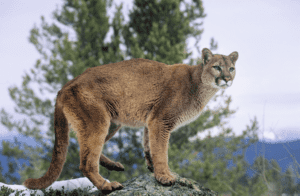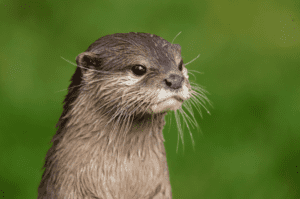Black bears are considered one of the largest predators. This large, stout carnivore is usually completely black except for a brown snout and sometimes a white “V” on its throat or chest. Males measure 51-75 inches in length (130-190 cm) and weigh 265-617 pounds (120-280 kg).
Female black bears are 43-67 inches (110-170 cm) long and weigh 100-400 pounds (45-182 kg). The black bear has several color phases, including black, brown, cinnamon, blond and white. It is like humans in being plantigrade, meaning it walks on the entire soles of its feet. The black bear is almost tailless.
Table of Contents
Habitat
Black bears prefer remote areas of mixed deciduous, coniferous forests with a thick understory. Den sites include areas underneath fallen trees, hollow logs or underground caves. This species is solitary except for females with cubs or in situations where food is abundant.
What do Black Bears Eat
An opportunistic omnivore, it feeds on berries, acorns and some leafy vegetation. This bear can kill deer and livestock but usually eats carrion as a meat source.
Black bears possess excellent senses of hearing and smell and can detect carrion from more than 1 mile away. Garbage, rather than livestock, is the essential food item provided by humans.
The home range of males may be up to 78 square miles (30.1 km2), with females travelling about half that area. The black bear is active throughout the day.
Reproduction Rate of Black Bears
Black bears have an extremely low reproductive rate closely tied to the food supply. Animals become sexually mature at 4-5 years, mate during mid-summer, but reproduce only every other year. A female has 2-3 cubs in late January or February while in her winter den. Cubs may stay with the female until nearly 1.5 years old, when the mother begins her reproductive cycle again.
Both males and females hibernate in the winter, generally under brush piles, tree downfalls or rock ledges. Denning allows bears to survive harsh weather conditions and a lack of winter food. Although body temperature drops and heart rate slows, bears will awaken from hibernation if disturbed.
A black bear may line its den with vegetation and close the entrance, making the den warmer and more camouflaged.
Amazing Facts About Black Bears
- Black bears are an important part of the ecosystem, helping to keep the populations of small animals in check.
- Black bears are excellent tree climbers and can run up to 35 miles per hour.
- Black bears are also good swimmers and have been known to swim up to six miles across open water.
- Black bears have been known to attack humans on occasion, but are usually not very aggressive unless provoked.
- In most cases, black bear attacks can be avoided by making loud noises, shining a light in their eyes, or trying to scare them off with pepper spray or a firearm.
- Black bears are becoming increasingly common in urban areas, where they often raid trash cans and bird feeders for food.
Where are Black Bears Found
The black bear is distributed throughout North America north of central Mexico, except for the southwestern United States. Substantial populations are found only in the northwestern states, the Rockies, northern Minnesota, Wisconsin, Michigan, Maine, and most of Alaska.
In South Dakota, this species has been observed in the Black Hills region of Custer County, although its distribution may be more widespread.
Conservation Measures:
Historically, bears were despised and killed as harmful predators. Black bears are now recognized as valuable game animats and components of our remaining wilderness. The researchers of Oklahoma state university is conducting research and finding solutions on the coexistence of human and black bear.
Unfortunately, people often fail to realize how strong, unpredictable and destructive a bear can be. Females with cubs are protective and aggressive.
Campgrounds and garbage dumps are regarded by bears as food sources, increasing the likelihood of confrontations between people and bears.
The total range of the black bear may decrease as human encroachment increases. Public education will undoubtedly contribute to the possibility of the coexistence of bears and humans.
Habitat preserves may be needed in areas of dwindling black bear populations. The existence of a breeding black bear population in South Dakota is uncertain.
Read Also: River Otter-Size, Habitat, Diet And Interesting Facts
Article research: Oklahoma State University Study on human and black bear coexistence.





